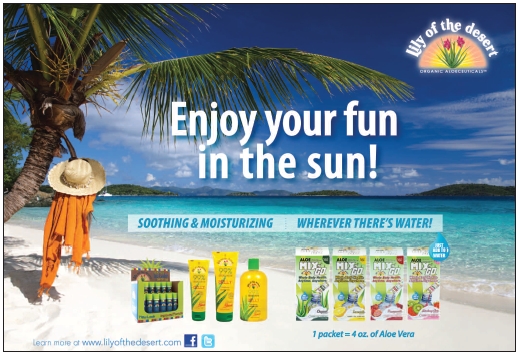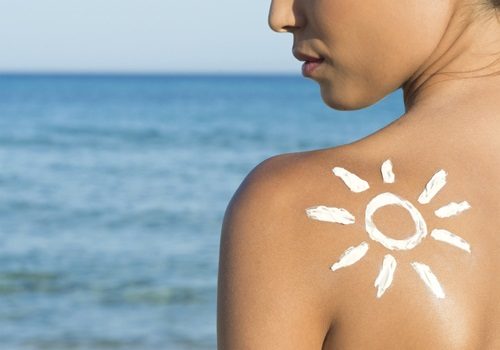Flip-flops? Check. Beach towel? Check. Hazardous chemicals masquerading as sun protection? Check! Your customers may think they’re protecting their skin by packing that drug store SPF 50 product, but questionable ingredients should make them think twice. Ensure your customers enjoy the summer sun safely with these natural sun care products.
The Danger
Everyone should be careful to properly protect themselves when they’re going to be out in the sunlight for any period of time. Ultraviolet (UV) radiation (of which there are two main types: UVA and UVB) from the sun can cause sunburn, skin damage and skin cancer (1). Sunscreen bottles advertise their sun protection factor (SPF), which tells the consumer what percentage of the UVB rays the sunscreen is filtering out; for example, SPF 15 filters out 93% of all UVB rays, and SPF 50 filters out 98% (2). However, SPF does not indicate UVA protection. Reddening of the skin (sunburn) is caused solely by UVB rays, so even if the skin does not visibly react, UVA rays could still be causing lasting damage.
There’s more to sunscreens than the SPF number, and some  ingredients could do far more harm than good. A common chemical found in traditional sunscreen is oxybenzone, which can penetrate the skin, enter the bloodstream and act like estrogen in the body, as well as cause allergic reactions (3). Studies have found a link between oxybenzone and endometriosis, a condition that causes painful growth of uterine tissue outside the organ (3). Retinyl palmitate, used in sunscreens for anti-aging effects, may speed up the development of skin lesions or tumors when exposed to the sun (3).
ingredients could do far more harm than good. A common chemical found in traditional sunscreen is oxybenzone, which can penetrate the skin, enter the bloodstream and act like estrogen in the body, as well as cause allergic reactions (3). Studies have found a link between oxybenzone and endometriosis, a condition that causes painful growth of uterine tissue outside the organ (3). Retinyl palmitate, used in sunscreens for anti-aging effects, may speed up the development of skin lesions or tumors when exposed to the sun (3).
These chemicals could be detrimental to more than just humans, too. A recent study from marine scientists at the U.S. National Oceanic & Atmospheric Administration found that benzophenone-2 (BP-2), an ingredient in UV ray protective cosmetics, soaps and laundry detergents, can kill young ocean corals, bleach them or even cause damage to their DNA. Over 80% of the Caribbean coral reefs have disappeared since the 1960s, around the time BP-2 was introduced (4).
Natural Sun Care
Luckily, there are options for those who want full sun protection without the damaging chemicals! The natural active ingredient zinc oxide sits on the top layer of skin and protects the lower levels by absorbing UVA, UVB and even UVC (5)! Titanium dioxide can also be used in sunscreens as it reflects, scatters and absorbs UV light to protect the skin beneath it (6). Inactive  ingredients are used as a base for the sunscreen lotion and often moisturize or soothe the skin. Aloe vera can store moisture in its thick green leaves for days, a defense mechanism in case of drought (7). It can be used as a gentle and non-greasy base for lotions that soothe and rehydrate sun-damaged skin (5). Shea butter provides a creamy texture as well as the skin-healing vitamins A and E, while cocoa butter serves as a protective moisture barrier from the elements (5). Other common bases include sunflower and olive oils (rich in antioxidants), as well as jojoba and organic beeswax (which moisturize) (5).
ingredients are used as a base for the sunscreen lotion and often moisturize or soothe the skin. Aloe vera can store moisture in its thick green leaves for days, a defense mechanism in case of drought (7). It can be used as a gentle and non-greasy base for lotions that soothe and rehydrate sun-damaged skin (5). Shea butter provides a creamy texture as well as the skin-healing vitamins A and E, while cocoa butter serves as a protective moisture barrier from the elements (5). Other common bases include sunflower and olive oils (rich in antioxidants), as well as jojoba and organic beeswax (which moisturize) (5).
If your customers take all the proper precautions and still get mild to moderate sunburn, there are cooling relief options out there for them. Aside from acting as a base for sunscreens, Aloe vera is a powerful hydrator that can soothe sunburned skin, especially when kept cold before applying. Other after-sun care products combine natural oils and extracts to soothe, nourish and moisturize the skin, and should be used even if the skin shows no visible effects from the sun. Linden extract is a common ingredient in after-sun care. Made from the flowers of the linden tree, it has soothing properties and is full of antioxidants to rejuvenate the skin. Coconut oil and bee pollen are rich in vitamins, minerals, amino acids and enzymes, and are also good moisturizing and nourishing ingredients to look for in an after-sun care product (8).
Vitamin D
For those concerned about getting their daily dose of vitamin D, the experts suggest looking for sources other than sunlight. Though our bodies produce vitamin D when exposed to UVB rays, it’s only in a limited amount, especially for the elderly and those with dark skin, says Roy Geronemus, M.D., clinical professor of dermatology at New York University Medical Center (9). According to Geronemus, levels of vitamin D can actually be decreased with prolonged sun exposure, so it’s best to rely on food sources and supplements to get the recommended 600 IUs of vitamin D a day. WF
References
1. Skin Cancer Foundation, “Sunscreen,” www.skincancer.org/prevention/sun-protection/sunscreen, accessed Mar. 3, 2014.
2. Skin Cancer Foundation, “Sunscreens Explained,” www.skincancer.org/prevention/sun-protection/sunscreen/sunscreens-explained, accessed Mar. 3, 2014.
3. Environmental Working Group, “What Not to Bring on Vacation,” www.ewg.org/2013sunscreen/what-not-to-bring-on-vacation, accessed Mar. 2, 2014.
4. C.A. Downs, et al., “Toxicological Effects of the Sunscreen UV Filter, Benzophenone-2, on Planulae and in vitro Cells of the Coral, Stylophora pistillata,” Ecotoxicol. 23 (2), 175–191 (2014).
5. Badger Balm, “Badger Sunscreen Ingredients,” www.badgerbalm.com/s-64-badger-sunscreen-ingredients.aspx, accessed Mar. 4, 2014.
6. Royal Society of Chemistry, “Chemistry in its Element: Titanium Dioxide,” www.rsc.org/chemistryworld/podcast/CIIEcompounds/transcripts/titanium_dioxide.asp, accessed Mar. 4, 2014.
7. Aubrey Organics, “Aloe,” www.aubrey-organics.com/custom.aspx?id=100, accessed Mar. 7, 2014.
8. Burt’s Bees, “Aloe & Linden Flower after Sun Soother,” www.burtsbees.com/Aloe-Linden-Flower-After-Sun-Soother---6-fl.-oz./19499-00,default,pd.html, accessed Mar. 10, 2014.
9. Skin Cancer Foundation, “Make Vitamin D, Not UV, a Priority,” www.skincancer.org/healthy-lifestyle/vitamin-d/make-vitamin-d-not-uv-a-priority, accessed Mar. 5, 2014.
Published in WholeFoods Magazine, June 2014










